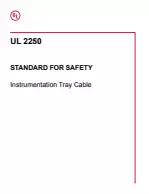UL 2250:2021 PDF Download
Standard EN SampleStandard for Instrumentation Tray Cable
Also Known As:
The UL 2250:2021 standard specifies the requirements for Type ITC instrumentation control cables. These cables consist of two or more current-carrying copper or thermocouple alloy conductors, with optional grounding conductors and/or optical-fiber members, all under an overall jacket.
The cables covered by this standard are intended for use on circuits rated 150 V or less and 5 A or less, in accordance with applicable parts of the National Electrical Code (NEC). Although they are rated 300 V, they are not marked as such, except for direct-burial cables.
These cables comply with specific flame tests, either the UL Flame Exposure or FT4/IEEE 1202 Type of Flame Exposure, as described in UL 1685. For limited-smoke cables, the UL test or FT4/IEEE 1202 test can be used, both with smoke measurements included.
If a cable contains electromagnetic shields, it may be surface marked or have a marker tape indicating that it is "shielded." Cables containing optical-fiber members are marked with "-OF" and are limited to carrying optical energy that is deemed non-hazardous to the human body.
All Type ITC cables qualify for exposure to sunlight and must undergo a 720-hour sunlight-resistance test. Although marking is not required, a "sun res" or "sunlight resistant" indication may be present on the tag or visible through the jacket.
These cables may have a metal sheath or armor over the non/metallic jacket, and the overall jacket is designed to be a gas/vapor-tight continuous sheath as discussed in the National Electrical Code.
Finally, cables marked with "-ER" are suitable for exposed runs not exceeding 50 ft (15.2 m) between a cable tray and equipment, with support and securing every 6 ft (1.8 m). The standard does not cover the optical or other performance aspects of the optical-fiber members.
| Edition | 3 |
| Language(s) | English |
| File Size | 532.5 KB |


